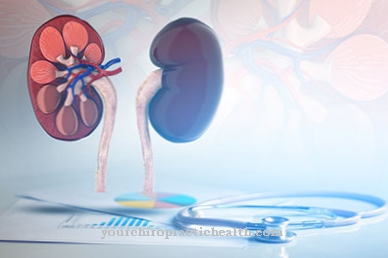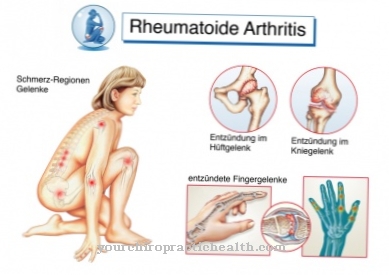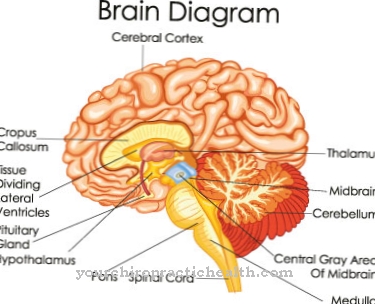Under a Vertebral fracture the fracture of a vertebra is understood. This affects the vertebral body, the vertebral arch or the spinous process.
What is vertebral fracture?
At a Vertebral fracture a part of the vertebra breaks. These include the vertebral arch, the vertebral body or the spinous process. Most are Vertebral fractures the consequence of a minor accident. But they can also occur spontaneously as a result of an illness. These primarily include pronounced bone loss (osteoporosis) or tumor metastases in the spinal column area.
The most common vertebral fractures are in the lumbar spine (LWS) and thoracic spine (thoracic spine). In Germany alone there are around 6,000 vertebral fractures every year. In the case of severe spinal injuries, there is even a risk of permanent paralysis in the worst case.
causes
The causes of vertebral fractures are different. In young people, they often occur as a result of traffic accidents, work accidents, accidents in the household, falls, sports injuries such as skiing or horse riding, or after physical violence. In seniors, however, vertebral fractures are also possible without any specific external impact, because their bone structure is already suffering from previous damage.
Osteoporosis is the most common reason for a vertebral fracture caused by illness. Other pathological causes such as osteitis (inflammation of the bones), softening of the bones (osteomalacia), rheumatism, bone cancer or metastases on the skeleton are also possible triggers. The vertebral fracture occurs without a recognizable cause such as an accident. Even everyday stresses lead to a fracture of the vertebra, because the bones are significantly less stressed due to the disease.
Symptoms, ailments & signs
Back pain that sets in suddenly is a typical symptom of a vertebral fracture. Even at rest, the pain is more or less pronounced. The symptoms usually increase with movement. If there is a fracture in the cervical area, the patient is no longer able to move his head properly. Because of this, he keeps him in a forced position.
Other possible indications of a vertebral fracture are abrasions, a hematoma (bruise) and misalignments. Sometimes the spinous processes are at a greater distance from one another than usual at the fracture site. If the nerves or the spinal cord are also affected by the vertebral fracture, further symptoms occur. This can be muscle weakness, muscle paralysis, numbness or incontinence. Paraplegia is also conceivable.
An indication of a vertebral fracture caused by osteoporosis is a rapid loss of height in the person concerned. The patient loses several centimeters in size.
Diagnosis & course of disease
If a vertebral fracture is suspected, the doctor first looks at the patient's medical history and has the triggering accident describe in detail. The symptoms and the type of injury can also provide important information about the condition of the person concerned. A possible indication of a vertebral fracture is pressure or tapping pain in a certain section of the spine.
After a physical examination, the nerve functions are assessed. In addition, an X-ray examination is carried out to confirm the diagnosis. X-rays of multiple sites in the spine can be taken to determine if a vertebral fracture has occurred. This method can be used to detect instabilities. If the patient is unconscious, the entire spine must be x-rayed.
If the X-ray examination actually reveals a vertebral fracture, a computed tomography (CT) is carried out to determine the damage to other body structures such as the spinal canal. The course of a vertebral fracture depends on its extent. In this way, certain malpositions cannot always be prevented. Overload symptoms are also possible, but these do not always result in pain. If there is osteoporosis, there is a risk of further vertebral fractures.
Complications
There is usually a good chance of recovery from a vertebral fracture. However, in some cases complications can arise, which can sometimes have serious consequences. This is especially the case when nerve tissue is injured. Sometimes there is also a narrowing of the spinal canal.
Neighboring segments can also be degenerate. Whether there are complications also depends on the type of vertebral fracture. So there are stable and unstable vertebral fractures. A stable vertebral fracture is characterized by undamaged soft tissues and ligaments around the fracture. There are no neurological disorders here. Whole vertebral sections are deformed in unstable vertebral fractures.
There is a high risk here that dislocated bone fragments injure the spinal cord. In extreme cases, the unstable vertebral fracture can therefore even cause paraplegia. In addition to the spinal cord injury, the long-term consequences of a vertebral fracture can also result in balance disorders, post-traumatic kyphosis or post-traumatic scoliosis.
When the vertebrae collapse forward, what is known as a widow's hump, also known as kyphosis, occurs. Scoliosis (lateral bending of the spine) is caused by lowering the side edges. This leads to increased stress on the intervertebral discs in this area. The spinal deformations can also be associated with restricted mobility and pain.
When should you go to the doctor?
You need to see a doctor as soon as you experience pain in the back or mobility restrictions after an accident, a fall or an act of violence. If the back can no longer be moved as usual, action is required. Feelings of numbness, impaired sensitivity and a sudden loss of physical performance indicate a health disorder. Since severe cases can lead to lifelong impairments, a doctor should be consulted as soon as possible. If incontinence occurs, this is to be interpreted as a warning signal from the organism.
If the person concerned can no longer move without help and if he adopts a forced posture, a doctor is needed. In particularly acute cases, a rescue service must be alerted. Until it arrives, first aid measures must be taken and the instructions of the emergency medical team must be followed. To avoid complications, it is important not to make jerky movements. A vertebral fracture is characterized by pain and discomfort, which also occur at rest. Even minor movements can lead to intense pain attacks. If the head or the limbs cannot be moved at all or only to a limited extent, this is also worrying and should lead to a doctor's visit.
Therapy & Treatment
A vertebral hernia can be treated both conservatively and surgically. If the fracture was caused by an accident, the fracture is first stabilized in order to counteract further damage to the vertebra or the spinal cord.
If there is no risk of instability, conservative therapy is used. The patient has to stay in bed for a few days. The pain is treated with analgesics such as non-steroidal anti-inflammatory drugs (NSAIDs) or calcitonin. With the help of a chest corset and the help of a physiotherapist, the patient can usually get up again after a short time. Special exercises are also performed to train the back muscles.
In addition, the patients learn behaviors that have a positive effect on the back and are similar to a back school. While the first part of the treatment takes place in the hospital, the remaining part takes place after two to four weeks on an outpatient basis. In the case of a cervical vertebra fracture, the patient has to wear a so-called cervical brace for about 6 to 12 weeks. If an underlying disease such as osteoporosis is responsible for the vertebral fracture, it is also treated.
If the fracture is stable, surgery is only performed in the case of severe pain. The situation is different if there is an unstable break. In such cases, an immediate surgical procedure is necessary. The doctor bridges the unstable bone segments with metal screws or rods. In addition, narrowing of the spinal canal is corrected. Additional brace therapy is usually not necessary. After about 6 to 9 months, the stiffened segments will heal.
prevention
A vertebral fracture can be prevented in many cases. It is important to avoid accidents. For this purpose, traffic safety measures such as back protectors or seat belts can be used. In the case of osteoporosis, early therapy is recommended.
Aftercare
Follow-up care plays an important role after the actual treatment of a vertebral fracture. It helps to achieve freedom from pain and optimal mobility of the affected vertebrae. If the vertebral fracture has been treated surgically, one of the most important follow-up measures is restoring the stability of the spine. Follow-up treatment takes place as quickly as possible and includes physiotherapy and occupational therapy.
It is not uncommon for follow-up care to begin on the first day after the operation. Because usually only small incisions are made on the spine, the wound does not need special care. As part of physiotherapy, the patient exercises targeted and slow movements. However, it should be noted whether the vertebral fracture resulted in neurological deficits.
If the operation has restored the stability of the spine, the patient undergoes rehabilitation. It serves to enable the re-entry into working life. It is determined whether it is still possible to carry out the previous work activity. Professions that involve heavy physical strain are often seen as an obstacle. In most cases, those affected can go back to their usual work after eight to twelve weeks.
In some cases the vertebral fracture causes paralysis. The follow-up treatment should then ensure that the patient's independence is restored. If a wheelchair is necessary, it usually requires lifelong follow-up care.
You can do that yourself
In the event of a vertebral fracture, the organism must be spared sufficiently. Physical strain and any kind of overexertion must be avoided in principle. In most cases, sporting activities are to be avoided during the recovery process or only carried out in a reduced form.
In order not to take any risks or cause secondary diseases, it should be agreed in cooperation with the attending physician which types of sport may be practiced. At the same time, it must be checked to what extent professional activities can take place during the healing process or whether sick leave is necessary. The movements should never be jerky in everyday life. Avoid lifting and carrying heavy objects. The fulfillment of daily tasks must be restructured and should be carried out by people from the social environment. In the event of the first physical irregularities or abnormalities, the movements should be slowed down and optimized. In particular, the use of one-sided postures should be reduced to a minimum.
The muscles are to be protected from hardening. Careful, light massages or slow balancing movements help relieve discomfort or prevent pain. Physiotherapeutic measures additionally support the healing process and can be helpful in preventing further disorders. In addition, the sleeping habits must be optimized and adapted to current physical possibilities.



.jpg)


.jpg)




















